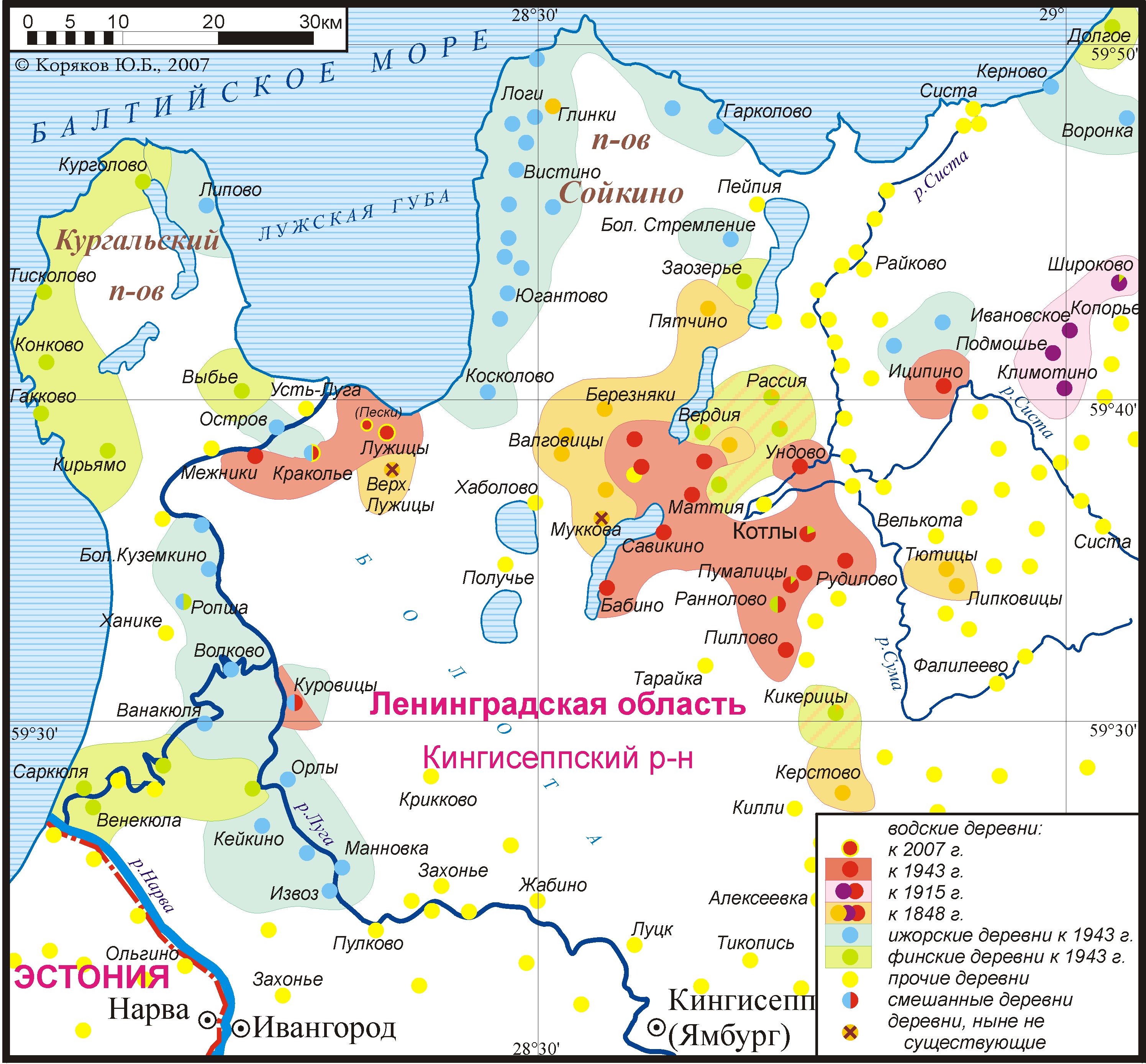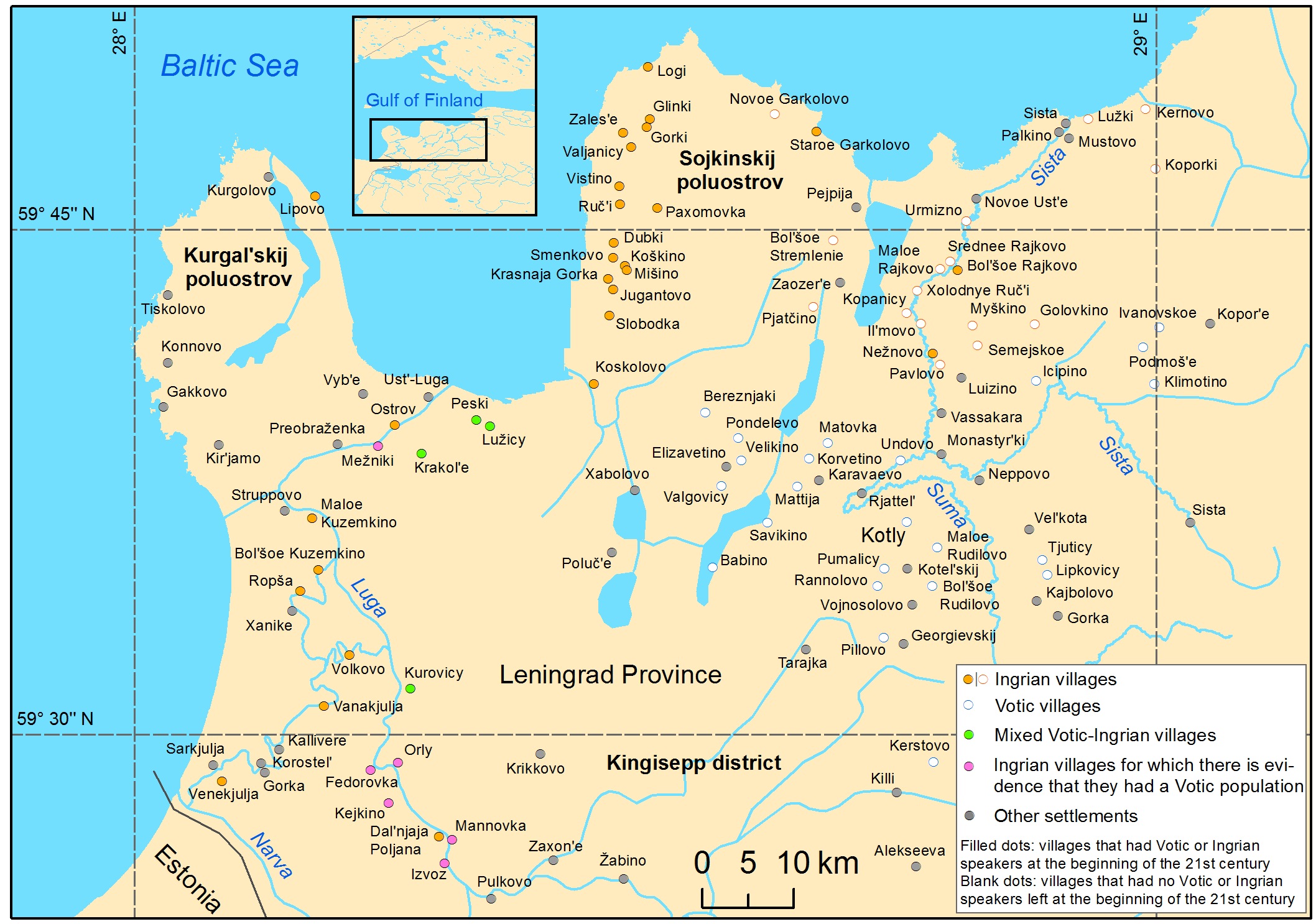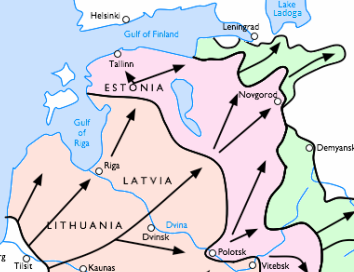|
Izhorian People
The Izhorians (; ; ; ) are a Finnic indigenous people native to Ingria. Small numbers can still be found in the western part of Ingria, between the Narva and Neva rivers in northwestern Russia. They are also referred to as Ingrians, although the term can also refer to the Ingrian Finns or the Baltic Finnic residents of Ingria in general. History The history of the Izhorians is bound to the history of Ingria. It is supposed that shortly after 1000 AD the Izhorians moved from Karelia to the west and south-west. In 1478, the Novgorod Republic, where Ingrians had settled, was united with the Grand Duchy of Moscow, and some of the Izhorians were transferred to the east. The establishment of St Petersburg in 1703 had a great influence on Izhorian culture. World War II had the biggest impact on Izhorians, as devastating battles (such as the Siege of Leningrad) took place on their territory. In 1848, P. von Köppen counted 17,800 Izhorians, and by 1926 there were 26,137 Izhorians ... [...More Info...] [...Related Items...] OR: [Wikipedia] [Google] [Baidu] |
Ingrian Language
Ingrian (, ), also called Izhorian (, , ), is a Finnic language spoken by the (mainly Orthodox) Izhorians of Ingria. It has approximately 70 native speakers left, most of whom are elderly. The Ingrian language should be distinguished from the Ingrian dialect of the Finnish language, which became the majority language of Ingria in the 17th century with the influx of Lutheran Finnish immigrants; their descendants, the Ingrian Finns, are often referred to as Ingrians. The immigration of Lutheran Finns was promoted by Swedish authorities, who gained the area in 1617 from Russia, as the local population was (and remained) Orthodox. Dialects Four dialect groups of Ingrian have been attested, two of which are probably extinct by now: * Hevaha, spoken along Kovashi River and nearby coastal areas (†) * Soikkola, spoken on Soikinsky Peninsula and along Sista River * Ylä-Laukaa (Upper Luga or Oredezhi), spoken along Oredezh River and the upper Luga River (†) * Ala-Laukaa (Lo ... [...More Info...] [...Related Items...] OR: [Wikipedia] [Google] [Baidu] |
Ukrainian Census (2001)
The 2001 Ukrainian census is to date the only census of the population of independent Ukraine. It was conducted by the State Statistics Committee of Ukraine on 5 December 2001, twelve years after the last Soviet Union census in 1989.In 2021, there will most likely be no all-Ukrainian census - Minister hromadske.ua (21 April 2020) The next Ukrainian census was planned to be held in 2011 but has been repeatedly postponed. [...More Info...] [...Related Items...] OR: [Wikipedia] [Google] [Baidu] |
Ukraine
Ukraine is a country in Eastern Europe. It is the List of European countries by area, second-largest country in Europe after Russia, which Russia–Ukraine border, borders it to the east and northeast. Ukraine also borders Belarus to the north; Poland and Slovakia to the west; Hungary, Romania and Moldova to the southwest; and the Black Sea and the Sea of Azov to the south and southeast. Kyiv is the nation's capital and List of cities in Ukraine, largest city, followed by Kharkiv, Odesa, and Dnipro. Ukraine's official language is Ukrainian language, Ukrainian. Humans have inhabited Ukraine since 32,000 BC. During the Middle Ages, it was the site of early Slavs, early Slavic expansion and later became a key centre of East Slavs, East Slavic culture under the state of Kievan Rus', which emerged in the 9th century. Kievan Rus' became the largest and most powerful realm in Europe in the 10th and 11th centuries, but gradually disintegrated into rival regional powers before being d ... [...More Info...] [...Related Items...] OR: [Wikipedia] [Google] [Baidu] |
Leningrad Oblast
Leningrad Oblast (, ; ; ) is a federal subjects of Russia, federal subject of Russia (an oblast). The oblast has an area of and a population of 2,000,997 (2021 Russian census, 2021 Census); up from 1,716,868 recorded in the 2010 Russian census, 2010 Census. Leningrad Oblast is highly industrialized. Its administrative center and largest city is Gatchina. The oblast was established on 1 August 1927, although it was not until 1946 that the oblast's borders had been mostly settled in their present position. The oblast was named after the city of Saint Petersburg, Leningrad. In 1991, the city restored its original name, Saint Petersburg, but the oblast retains the name of Leningrad. It overlaps the historical region of Ingria, and is bordered by Finland (Kymenlaakso and South Karelia) in the northwest and Estonia (Ida-Viru County) in the west, as well as five federal subjects of Russia: the Republic of Karelia in the northeast, Vologda Oblast in the east, Novgorod Oblast in the sou ... [...More Info...] [...Related Items...] OR: [Wikipedia] [Google] [Baidu] |
2002 Russian Census
The 2002 Russian census () was the first census of the Russian Federation since the dissolution of the Soviet Union, carried out on October 9 through October 16, 2002. It was carried out by the Russian Federal Service of State Statistics (Rosstat). Data collection The census data were collected as of midnight October 9, 2002. Resident population The census was primarily intended to collect statistical information about the resident population of the Russian Federation. The resident population included: * Russian citizens living in Russia (including those temporarily away from the country, provided the absence from the country was expected to last less than one year); * non-citizens (i.e. foreign citizens and stateless persons) who were any of the following: ** legal permanent residents; ** persons who have arrived in the country with the intent to settle permanently or to seek asylum, regardless of whether they have actually obtained the appropriate immigration status; ** author ... [...More Info...] [...Related Items...] OR: [Wikipedia] [Google] [Baidu] |
USSR
The Union of Soviet Socialist Republics. (USSR), commonly known as the Soviet Union, was a List of former transcontinental countries#Since 1700, transcontinental country that spanned much of Eurasia from 1922 until Dissolution of the Soviet Union, it dissolved in 1991. During its existence, it was the list of countries and dependencies by area, largest country by area, extending across Time in Russia, eleven time zones and sharing Geography of the Soviet Union#Borders and neighbors, borders with twelve countries, and the List of countries and dependencies by population, third-most populous country. An overall successor to the Russian Empire, it was nominally organized as a federal union of Republics of the Soviet Union, national republics, the largest and most populous of which was the Russian SFSR. In practice, Government of the Soviet Union, its government and Economy of the Soviet Union, economy were Soviet-type economic planning, highly centralized. As a one-party state go ... [...More Info...] [...Related Items...] OR: [Wikipedia] [Google] [Baidu] |
Russian SFSR
The Russian Soviet Federative Socialist Republic (Russian SFSR or RSFSR), previously known as the Russian Socialist Federative Soviet Republic and the Russian Soviet Republic, and unofficially as Soviet Russia,Declaration of Rights of the laboring and exploited people, article I. was a socialist state from 1917 to 1922, and afterwards the largest and most populous constituent republic of the Soviet Union (USSR) from 1922 to 1991, until becoming a sovereign part of the Soviet Union with priority of Russian laws over Union-level legislation in 1990 and 1991, the last two years of the existence of the USSR.The Free Dictionary Russian Soviet Federated Socialist Republic . Encyclopedia2.thefreedictionary.com. Retrieved on 22 June 2011. The Russ ... [...More Info...] [...Related Items...] OR: [Wikipedia] [Google] [Baidu] |
Siege Of Leningrad
The siege of Leningrad was a Siege, military blockade undertaken by the Axis powers against the city of Leningrad (present-day Saint Petersburg) in the Soviet Union on the Eastern Front (World War II), Eastern Front of World War II from 1941 to 1944. Leningrad, the country's second largest city, was besieged by Nazi Germany, Germany and Finland for 872 days, but never captured. The siege was the List of sieges, most destructive in history and possibly the List of battles by casualties#Sieges and urban combat, most deadly, causing an estimated 1.5 million deaths, from a prewar population of 3.2 million. It was not classified as a war crime at the time, but some historians have since classified it as a genocide due to the intentional destruction of the city and the systematic starvation of its civilian population. p. 334 In August 1941, Nazi Germany, Germany's Army Group North reached the suburbs of Leningrad as Finnish forces moved to encircle the city from the north. Land ... [...More Info...] [...Related Items...] OR: [Wikipedia] [Google] [Baidu] |
World War II
World War II or the Second World War (1 September 1939 – 2 September 1945) was a World war, global conflict between two coalitions: the Allies of World War II, Allies and the Axis powers. World War II by country, Nearly all of the world's countries participated, with many nations mobilising all resources in pursuit of total war. Tanks in World War II, Tanks and Air warfare of World War II, aircraft played major roles, enabling the strategic bombing of cities and delivery of the Atomic bombings of Hiroshima and Nagasaki, first and only nuclear weapons ever used in war. World War II is the List of wars by death toll, deadliest conflict in history, causing World War II casualties, the death of 70 to 85 million people, more than half of whom were civilians. Millions died in genocides, including the Holocaust, and by massacres, starvation, and disease. After the Allied victory, Allied-occupied Germany, Germany, Allied-occupied Austria, Austria, Occupation of Japan, Japan, a ... [...More Info...] [...Related Items...] OR: [Wikipedia] [Google] [Baidu] |
St Petersburg
Saint Petersburg, formerly known as Petrograd and later Leningrad, is the List of cities and towns in Russia by population, second-largest city in Russia after Moscow. It is situated on the Neva, River Neva, at the head of the Gulf of Finland on the Baltic Sea. The city had a population of 5,601,911 residents as of 2021, with more than 6.4 million people living in the Saint Petersburg metropolitan area, metropolitan area. Saint Petersburg is the List of European cities by population within city limits, fourth-most populous city in Europe, the List of cities and towns around the Baltic Sea, most populous city on the Baltic Sea, and the world's List of northernmost items#Cities and settlements, northernmost city of more than 1 million residents. As the former capital of the Russian Empire, and a Ports of the Baltic Sea, historically strategic port, it is governed as a Federal cities of Russia, federal city. The city was founded by Tsar Peter the Great on 27 May 1703 on the s ... [...More Info...] [...Related Items...] OR: [Wikipedia] [Google] [Baidu] |




